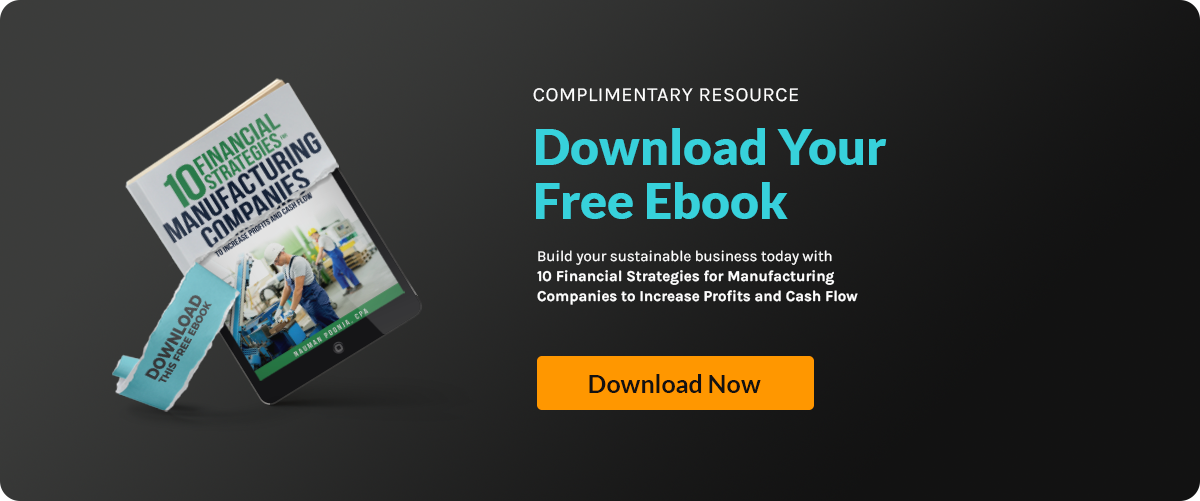Sales and use tax might seem small compared to equipment costs or payroll, but getting it wrong can...
Completing a Financial Health Check for Your Manufacturing Company

Running a manufacturing business means managing more than just production. It’s because you’re also keeping a close eye on your company’s financial well-being. A financial health check is like routine maintenance for your business, helping you spot risks and make smarter decisions. Companies that regularly analyze their finances can catch potential problems early and take action to avoid bigger issues down the line.
For manufacturers, understanding where your money is going and where it should be going is essential for long-term success. Continue reading to learn how to perform a financial health check and why it’s a crucial step toward building a stronger, more profitable operation.
What is Financial Health in Manufacturing?
In manufacturing, financial health refers to a company's finances' overall stability and viability. It encompasses generating consistent revenue, managing assets and liabilities effectively, and maintaining profitability. This stability allows a manufacturing business to invest in growth, handle unexpected expenses, and sustain long-term success.
Key Indicators of a Financially Healthy Manufacturing Business
- Cash Flow Management: Consistently positive cash flow is crucial for covering operating expenses, investing in new projects, and managing liabilities. Effective cash flow management ensures the business can meet its short-term and long-term obligations.
- Profit Margins: Healthy profit margins indicate the company effectively converts revenue into net profit. Monitoring the net profit margin helps business owners evaluate the efficiency of their operations and pricing strategies during each accounting period.
- Working Capital: Sufficient working capital is vital for day-to-day operations. It measures a company’s ability to cover its short-term liabilities with short-term assets. A positive working capital ratio ensures the business can maintain smooth operations.
- Quick Ratio: The quick ratio measures a company’s ability to meet its short-term obligations without relying on inventory sales. A high quick ratio indicates strong liquidity and finances, enabling the business to cover its liabilities at a specific time.
- Coverage Ratios: Coverage ratios, such as interest and debt service coverage, assess a company’s ability to meet its debt obligations. High coverage ratios suggest the business can comfortably manage its financing activities and non-cash transactions.
Considerations When Selecting the Right Financial Health Metric
Choosing the right metric depends on your manufacturing business's specific needs and goals. Here are key factors to consider:
- Operational Focus: Evaluate metrics like working capital and cash flow to ensure smooth day-to-day operations.
- Profitability Goals: Use profit margins to measure efficiency in converting revenue into profit.
- Debt Management: Monitor debt-to-equity ratios to maintain a balanced approach to funding and financial stability.
- Production Efficiency: Assess gross profit margins to track how well production costs are managed.
Comprehensive Assessment Methods
A comprehensive assessment is crucial for understanding a manufacturing company's financial health. Evaluating specific monetary metrics can provide insights into your company's financial position and performance. The following methods will help you make informed decisions and develop a robust business strategy.
Assessing Comprehensive Methods
A comprehensive assessment is crucial for understanding a manufacturing company's economic stability. Evaluating specific metrics can provide insights into your company's position and performance, helping you make informed decisions and develop a robust business strategy.
Reviewing the Cash Flow Statement
Analyzing the cash flow statement provides insights into how the company generates and uses cash. It helps determine the company’s ability to cover its expenses and invest in growth, ensuring liquidity and solvency.
Examining the Balance Sheet
The balance sheet offers a snapshot of the company’s financial position at a specific point in time. Key metrics to review include assets, liabilities, and equity, which help determine the company's economic well-being.
Analyzing the Income Statement
The income statement reveals the company’s performance over time by showing revenue, expenses, and net income. Gross and net profit margin are critical indicators of profitability and operational efficiency.
Measuring the Current Ratio
This metric measures the company’s ability to repay its short-term liabilities with its assets. A higher current ratio indicates better short-term financial health and liquidity.
Calculating the Debt-to-Equity Ratio
This solvency metric compares the company’s total liabilities to its equity. A lower debt-to-equity ratio means the company is less reliant on debt for its funding, indicating a healthier economic position.
Determining the Gross Profit Margin
This ratio shows the percentage of revenue that exceeds the cost of goods sold. It is a key indicator of the company’s profitability and efficiency in managing production costs.
Evaluating Valuation Metrics
Evaluating the business’s valuation metrics, such as the price-to-earnings ratio and enterprise value, helps determine its economic health relative to its performance against competitors and market expectations.
How Does a Company's Market Position Affect its Financial Health?
A company’s market position significantly influences its ability to set competitive prices, attract loyal customers, and sustain revenue growth. A strong market position enhances financial stability by providing greater pricing power and resilience against market fluctuations. A weak position can lead to reduced margins, higher competition, and challenges in maintaining profitability, making it essential to continually assess and strengthen market standing.
Expert Guidance for Improvement in Manufacturing
Improving the financial health of your manufacturing business requires strategic actions and expert advice. With the proper guidance, you can optimize finances, enhance profitability, and ensure long-term stability.
Here are essential ways experts can help improve your company's financial well-being:
1. Comprehensive Financial Statement Analysis
Experts thoroughly analyze your financial statements, including income, balance sheets, and profit-and-loss statements. This detailed review identifies trends, profitability, and areas needing attention, helping you make informed decisions and improve operational efficiency.
2. Cash Flow and Cost Optimization
Advisors monitor cash flow to ensure funds are available for growth opportunities while meeting obligations. They also help track both direct and indirect costs, identifying unnecessary expenses and improving resource efficiency.
3. Enhancing Accounting Practices
Implementing accrual accounting and maintaining healthy financial ratios provides a clearer view of monetary activities. Experts ensure accurate data and balanced financial health, using metrics like debt-to-equity ratios to guide your business strategies.
4. Strategic Reinvestment and Debt Management
Financial advisors develop reinvestment strategies to fuel growth, innovation, and competitiveness. They also evaluate obligations like loans and leases to maintain manageable debt levels and long-term stability.
5. Tailored Professional Advice
Experts provide customized guidance for navigating complex financial scenarios, optimizing asset management, and building robust business strategies. Their insights support sustainable growth and profitability.
Strategies for Long-term Financial Stability in Manufacturing
Achieving long-term financial stability in manufacturing requires strategic planning and careful resource management. By implementing effective strategies, entrepreneurs can ensure their businesses remain robust and competitive.
Here are the key strategies to help every manufacturing business.
Comprehensive Financial Planning
Develop detailed financial plans that provide insight into your company's financial health. These plans should include earnings before interest and tax projections, ensuring you can cover all financial obligations and reinvest in the business. Regularly review and update these plans to adapt to changing market conditions.
Working Capital Management
Effective working capital management is essential for maintaining liquidity and operational efficiency. Monitor your working capital to ensure you have enough resources to meet short-term needs and handle unexpected expenses.
This involves efficiently managing inventory, receivables, and payables. The cash flow statement is one critical document that shows the sources of cash and how it is used, providing vital information on your company’s liquidity.
Regular Financial Analysis
Conduct regular financial analysis to determine your company’s strengths and weaknesses. Use a variety of statements and ratios, such as the current and debt-to-equity ratios, to assess your company's overall performance.
No ratio or statement is sufficient; a comprehensive analysis is necessary to understand your business's profitability. Financial statements, created for any period, provide detailed insights and are essential tools for this analysis.
Risk Management and Contingency Planning
Identify potential financial risks and create contingency plans to mitigate them. A trial balance of transactions can help track financial activities and prepare for unforeseen events. This proactive approach ensures your business can withstand economic shocks and continue operating smoothly.
Strategic Investment and Reinvestment
Make informed investment decisions to support long-term growth. Assess the potential return on investment and consider market conditions and business needs. Reinvest profits into the business to drive innovation, improve processes, and expand capabilities, ensuring sustainable growth.
Optimizing Financial Reporting
Ensure that your financial reports are accurate and timely. This includes maintaining a detailed trial balance of transactions and using accrual accounting to provide a clear picture of economic performance.
Accurate financial reporting helps in making informed decisions and identifying areas for improvement. The cash flow statement, which shows the sources of cash and its uses, is crucial for understanding your business’s profitability.
Managing Debt Effectively
To maintain financial stability, keep debt levels manageable. Ensure that all obligations, especially those that must be repaid, are within your company’s capacity. Evaluate the terms of debt and seek to optimize interest rates to reduce financial burden.
Leveraging Financial Ratios
Utilize various financial ratios, such as the current, quick, and debt-to-equity ratios, to monitor your overall financial health.
These ratios fall into various categories, including liquidity, solvency, and profitability, and provide valuable insights into your financial strengths and weaknesses. They help you better understand your finances' sources and needs.
Implementing Cost Control Measures
Continuously monitor and control costs to improve profitability. Categorize expenses into direct and indirect costs and focus on reducing unnecessary expenditures. Effective cost management boosts your company's stability and supports sustained growth.
Getting Expert Guidance
Seek expert financial guidance to navigate complex financial landscapes and optimize your business strategy. Experts provide valuable insights into your business's economic stability, helping you make informed decisions and improve overall financial well-being. Their advice can be crucial in financial planning, risk management, and investment strategies.
Achieve Financial Excellence in Manufacturing—Trust Accounovation's Expert Guidance
Managing finances in manufacturing can be challenging, yet it's essential for stability and growth. You can improve efficiency, reduce costs, and boost profitability with the right financial strategies. Enhancing your financial health is vital to sustaining success and staying ahead in the industry.
Accounovation offers expert guidance tailored specifically for manufacturing businesses. Our comprehensive services include detailed financial analysis, strategic planning, and personalized advice to enhance financial performance.
Contact Accounovation today to start transforming your manufacturing finances.
Frequently Asked Questions
How do manufacturers know if they are making enough profit?
Profit margins are crucial for assessing whether a manufacturing company makes enough profit. Manufacturers can determine their profit by subtracting the costs of producing goods from the sales revenue. Critical profit margins to consider include:
- Gross Profit Margin: Sales revenue minus the cost of goods sold.
- Operating Profit Margin: Gross profit minus all operating expenses.
- Net Profit Margin: The remaining profit is after all expenses, including taxes and interest, have been deducted.
Why is checking how cash moves in and out of a business important?
Monitoring cash flow is essential for understanding the financial health of a company. It shows the real-time movement of money in and out of the business, indicating its ability to sustain operations, fund investments, and grow. Key aspects to watch include:
- Operational Cash Flow: Money generated from daily business activities.
- Investment Cash Flow: Cash used for or generated from buying and selling assets.
- Financing Cash Flow: Cash exchanges between the company and its owners, investors, or creditors.
Why is managing company assets important to a manufacturing business's success?
Efficient asset management optimizes the use of company resources, which is vital for cost-saving and enhancing production efficiency. Effective asset management involves:
- Regular Maintenance: Ensures machines and equipment function optimally, preventing costly breakdowns.
- Asset Utilization: Monitoring and improving asset use can increase production without additional costs.
- Lifecycle Management: Understanding and managing the lifecycle of assets from purchase to disposal to maximize their value and efficiency during use.
What indicators should manufacturers monitor to ensure their company is performing well?
Monitoring key performance indicators (KPIs) is essential for gauging your company's health. Important metrics include:
- Production Output: Measures the total quantity of goods produced.
- Efficiency Rates: Assesses the speed and effectiveness of production processes.
- Quality Control Measures: Tracks the rate of product defects and customer returns. These indicators help identify operational strengths and areas for improvement.
How can manufacturers measure their company’s capacity for growth?
Evaluating your company's scalability involves examining the following:
- Current Production Capabilities: Assess if existing facilities and equipment can increase output.
- Market Demand Forecasts: Analyze trends to predict future sales potential.
- Expansion Feasibility: Determine if there is physical and logistical room for growth. Assess whether your infrastructure can handle increased production and if there is potential to expand your market presence.
Why is it important to regularly review supplier and vendor contracts?
Regular reviews of contracts with suppliers and vendors ensure that terms remain competitive and supportive of your operational goals, potentially leading to the following:
- Cost Savings: Negotiate better pricing or terms.
- Improved Supply Chain Efficiency: Optimize logistics and inventory management.
- Enhanced Product Quality: Ensure suppliers meet quality standards. This can lead to cost savings and improved supply chain efficiency, which is crucial for maintaining a healthy operational base.
How do debt levels affect a manufacturing company's operations?
Managing debt responsibly ensures that borrowing costs do not hinder operational flexibility. Important considerations include:
- Interest Rates: Lower rates can reduce the cost of borrowing.
- Debt-to-Equity Ratio: Maintains a balance between borrowed funds and owned capital.
- Cash Flow Impact: Ensures debt repayments do not disrupt operational cash needs. Keeping debt manageable allows for smoother cash flow management and investment in growth opportunities without undue stress.
What role does customer satisfaction play in assessing a company’s performance?
High customer satisfaction levels are a strong indicator of a company’s health. Satisfaction metrics can include:
- Feedback Scores: Ratings provided by customers on products and services.
- Repeat Customer Rate: The percentage of customers who return for additional purchases.
- After-Sales Support Quality: Effectiveness of customer service post-purchase. These metrics provide insights into product quality, customer service effectiveness, and potential areas for product or service improvement.







